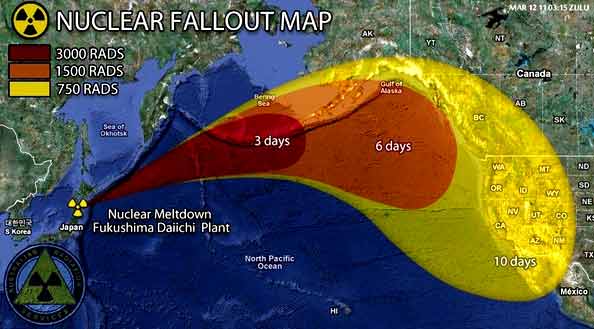Radiation Poisoning from Japan Reaches the United States

It’s was only a matter of time before we started to feel the effects of the Japanese tsunami on the west coast of North America. First, it was the appearance of debris that started washing ashore after currents carried them across the Pacific. Now, we’re facing problems related to the radiation poisoning of marine life. This is a problem that has the potential to alter the entire ecosystem of the Pacific Ocean and beyond, in addition to causing permanent damage to one of the primary sources of our seafood supply.
How it Happened

The process of radiation poisoning is simple. When radiation started to leak into the Pacific Ocean next to the nuclear power plant in Fukushima, marine life was immediately exposed. There is a continual argument as to how diluted the radiation was as it dispersed into the water. However, the reality is that it killed huge amounts of a range of marine life. Not all species have been affected since each has different levels of tolerance to exposure.
So, many died while others became ill and deformed. Then there were many species that lived and remained healthy enough to reproduce. The offspring from some of these fish became mutated. Then, other species would eat and ingest contaminated fish and organisms, and the toxic material would be absorbed into their flesh. This is just a small glimpse into a complex problem that is still far from being understood. The full impact that this radioactive leak has is still not known as well.
What is Happening Now

Many species of marine life use ocean currents to move from one place to another. This is one way that we are starting to see contaminated species showing up as far north as Alaska, south as Hawaii and east as the west coast of North America. Then you factor in the food chain that supports all life in the ocean. Bigger creatures eat smaller ones. Scavengers feed off of remnants on the sea floor, other creatures eat them, and up the food chain we go.
In terms of scavengers, not only are they ingesting contaminated remnants marine creatures, but they are also exposing themselves to contaminated particles that have settled on the floor as well. So, a fish that may be 10 times removed from the crab or shrimp that ingested radioactive material may still have traces of radiation in their bodies.
So the indirect consequences of radiation exposure can produce risks that can impact us here as well. The question is what do we have to worry about, and the answers are still elusive at this point.
What Can We Expect?

We don’t know. There are tens of thousands of different species in the Pacific Ocean, and many of them are not well-known. How they impact the food chain and the long-term consequences of radiation exposure have yet to be determined. Keep in mind that radiation doesn’t disappear. It can move from one source to another, but it lingers for thousands of years. So, it may be found in small amounts in fish, but those totals add up, and it’s not beyond the realm of possibility that we could end up slowly killing ourselves through the normal course of eating.
This is something that we shouldn’t get panicked about quite yet, as there is no evidence that levels of radiation in fish that we normally eat on an annual basis pose a threat. However, it’s the unknowns that we need to worry about more than anything. How will radiation impact the health of fisheries? How will exposure alter the stocks of fish that we normally harvest and put in our food supply? What other by-products of the tsunami will be discovered in the future?
Unfortunately, the government isn’t going to be forthcoming about information due to the panic that it would generate. The fishing industry will do what it can to downplay the scope of the problem in the interests of generating profits. Consumers will hardly think twice about the risks because they don’t hear about them from the government or the media. All of this is a recipe for disaster that will become more apparent over the course of time.
One thing is for certain. We are seeing an increase in irradiated marine life making their way to the West Coast. The question is what can we do to prevent exposure and ensure that our food supplies are safe, and answers are still a long way off.
